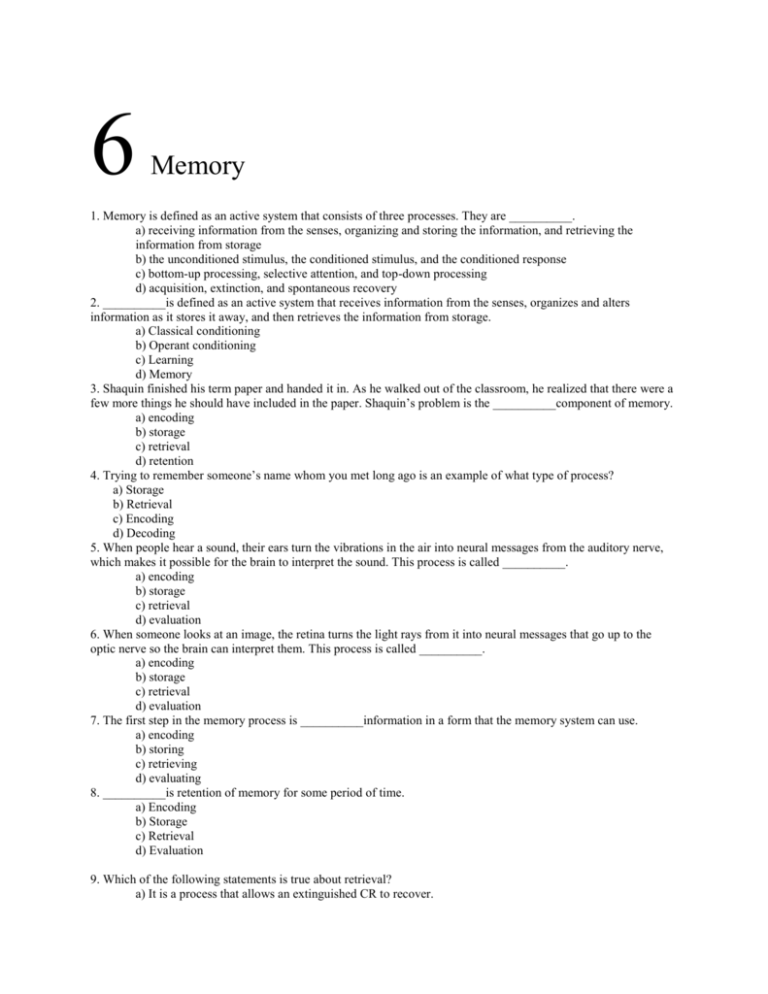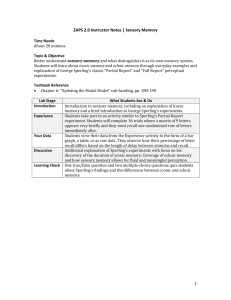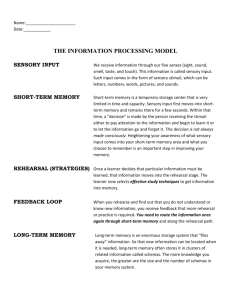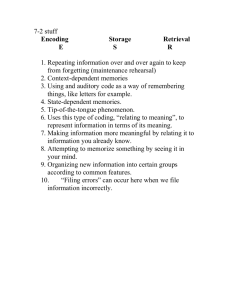6 Memory 1. Memory is defined as an active system that consists of
advertisement

6 Memory 1. Memory is defined as an active system that consists of three processes. They are __________. a) receiving information from the senses, organizing and storing the information, and retrieving the information from storage b) the unconditioned stimulus, the conditioned stimulus, and the conditioned response c) bottom-up processing, selective attention, and top-down processing d) acquisition, extinction, and spontaneous recovery 2. __________is defined as an active system that receives information from the senses, organizes and alters information as it stores it away, and then retrieves the information from storage. a) Classical conditioning b) Operant conditioning c) Learning d) Memory 3. Shaquin finished his term paper and handed it in. As he walked out of the classroom, he realized that there were a few more things he should have included in the paper. Shaquin’s problem is the __________component of memory. a) encoding b) storage c) retrieval d) retention 4. Trying to remember someone’s name whom you met long ago is an example of what type of process? a) Storage b) Retrieval c) Encoding d) Decoding 5. When people hear a sound, their ears turn the vibrations in the air into neural messages from the auditory nerve, which makes it possible for the brain to interpret the sound. This process is called __________. a) encoding b) storage c) retrieval d) evaluation 6. When someone looks at an image, the retina turns the light rays from it into neural messages that go up to the optic nerve so the brain can interpret them. This process is called __________. a) encoding b) storage c) retrieval d) evaluation 7. The first step in the memory process is __________information in a form that the memory system can use. a) encoding b) storing c) retrieving d) evaluating 8. __________is retention of memory for some period of time. a) Encoding b) Storage c) Retrieval d) Evaluation 9. Which of the following statements is true about retrieval? a) It is a process that allows an extinguished CR to recover. b) It is a process of getting stored memories back out into consciousness. c) It is a process of getting information from the sensory receptors to the brain. d) It is the reason that conditioned taste aversions last so long. 10. Janie is taking an exam in her history class. On the exam there is a question that asks her to state and discuss the five major causes of the Trans-Caspian War (whatever that was!). Janie remembers four of them. She knows there is a fifth, but time is up. As Janie is walking down the stairs, all of a sudden, she remembers the fifth point, but it is too late. Janie had a problem with __________. a) encoding b) storage c) retrieval d) evaluation 11. The processes of encoding, storage, and retrieval are seen as part of the __________model of memory. a) information processing b) top-down storage c) classical conditioning d) Tolman’s cognitive 12. In the levels-of-processing model of memory, information that gets processed at a __________level (such as accessing the meaning of a word or phrase) is more likely to be retained longer and form a stronger memory than information that is processed at a __________level (such as the visual characteristics of a word). a) deeper; shallower b) shallower; deeper c) higher; lower d) lower; higher 13. According to Craik and Lockhart, we are most likely to remember information that we process at a __________level. a) deeper b) medium c) shallower d) any of these, depending on the information 14. The levels-of-processing concept of Craik and Lockhart would suggest that which of the following questions would lead to better memory of the word frog? a) “Does it rhyme with blog?” b) “Is it in capital letters?” c) “Is it written in cursive?” d) “Would it be found in a pond?” 15. Which of the following examples represents the shallowest processing as described by Craik and Lockhart? a) recalling an object’s function b) attending to the sound of a word c) thinking about the meaning of a word d) recalling that an object was rectangular 16. Which model of memory proposes that the deeper a person processes information, the better it will be remembered? a) levels-of-processing model b) parallel distributed processing model c) information-processing model d) three stage 17. Craik and Lockhart’s model of memory states that how long a memory will be remembered depends on __________. a) the type of memory it is stored in b) the place in the brain where the memory is stored c) the amount of extinction that the memory has suffered d) the depth of processing associated with learning the materials 18. Believers in the information-processing model of memory are likely to agree that __________. a) the brain has nothing in common with a computer b) studying computers can give you useful insights into human information processing c) auditory information is retained in the sensory register for up to 2 seconds d) information flows from one memory system to the next 19. Which of the following examples represents deep processing as described by Craik and Lockhart? a) repeating a word aloud ten times b) attending to the sound of a word c) thinking about the meaning of a word d) looking at the shapes of the letters in a word 20. In the __________model, memory is seen as a simultaneous process, with the creation and storage of memories taking place across a series of networks “stretched” across the brain. a) levels-of-processing b) parallel distributed processing c) transfer-appropriate processing d) information-processing 21. In the parallel distributed processing model of memory, __________. a) information is simultaneously stored in a network that stretches across the br b) information is stored simultaneously in unconnected regions of the brain c) information is associated in sets of classically conditioned neurons across the neocortex d) None of these are correct. 22. Information is simultaneously stored across a network that stretches across the brain in the __________. a) Craik and Lockhart model of memory b) multistore model of memory c) information-processing theory of memory d) parallel distributed processing model of memory 23. Which model of memory is most similar in conceptualization to the way computers function? a) Craik and Lockhart’s model b) extinction c) information-processing model d) parallel distributed processing model 24. The three parts of the information-processing model of memory are __________. a) sensory memory, short-term memory, and long-term memory b) CS, UCS, UR, and CR c) encoding, storage, and retrieval d) shallow, medium, and deep processing 25. Why did research participants in Sperling’s experiment recall so few letters stored in sensory memory? a) They stopped paying attention after a few stimuli. b) Proactive interference reduced the effectiveness of recall. c) The stress of participating in this research became excessive. d) The remaining stimuli quickly faded from sensory memory. 26. Which memory system provides us with a very brief representation of all the stimuli present at a particular moment? a) primary memory b) sensory memory c) long-term memory d) short-term memory 27. A display of 12 letters is flashed on a screen in front of you followed by a tone. You attempt to recall a portion of the display based on the specific tone you heard. What aspect of your memory is this experiment designed to assess? a) primary memory b) sensory memory c) long-term memory d) short-term memory 28. You are out for a drive with the family and are lucky enough to get a window seat. The rapidly passing scenery you see out the window is first stored in __________. a) echoic memory b) iconic memory c) long-term memory d) short-term memory 29. The fleeting images we see as we look out the car window occur in ________. a) sensory memory b) short-term memory c) semantic memory d) working memory 30. Long ago, during the early days of television, when a television set was turned off it took a while for the last image that was on the screen to fade away. This phenomenon is most like __________. a) iconic memory b) echoic memory c) short-term memory d) long-term memory 31. Using the partial report method, Sperling found the capacity of iconic memory to be around __________. a) four or five items b) nine or ten items c) all the letters present d) one to two items 32. The key to the partial report method of Sperling’s study of sensory memory was to __________. a) have the participants report the entire matrix of letters they saw as fast as they could b) have the participants report the entire matrix of letters but mask the letters after presentation with a very bright light c) cue the participants, using a tone, as to which line of the matrix they were to report d) test the use of chunking 33. In the partial report method of Sperling’s study of sensory memory, the participants were to report __________. a) one of three lines of letters as indicated by the sound of a tone immediately presented after the letters had disappeared b) only one or two of the letters in the cued line c) the first letter of each line only d) the middle letter of each line 34. Iconic memory is to echoic memory as ________. a) implicit is to explicit b) auditory is to visual c) visual is to auditory d) quick is to slow 35. Which of the following distinguished sensory memory (SM) from short-term memory (STM)? a) STM holds only a small amount of separate pieces of information b) STM holds a large amount of separate pieces of information c) SM holds a large amount of separate pieces of information d) STM holds a small amount of uniform information 36. Which of the following might be the most appropriate analogy for eidetic imagery? a) a table b) a modem c) a rainbow d) a photograph 37. A time machine provides you the opportunity to interview Sigmund Freud. During the interview, Freud admits that he never wanted to attend medical school. When you ask him how he made it through, he says, “I had eidetic imagery.” What does he mean by that? a) He relied on the ability to associate odd images with material he needed to remember. b) He had a photographic memory, which helped him remember the material he had to learn. c) He was able to imagine how cells in a patient’s body were acting when he prescribed drugs and, thus, he could adjust dosages. d) In order to remember the long list of diseases he would encounter, he created drawings that helped him remember. 38. One problem with relying on eidetic imagery to study for tests is that _________. a) you remember too much material and the professor will think you are cheating b) eidetic images fade in .25 second as Sperling has shown c) you may be able to recall the material but you don’t necessarily understand it d) it only helps you remember things from other cultures 39. What is one of the real-world uses of iconic storage? a) It is where photographic memories are kept. b) It is the process that covers up the disruption that would occur from saccades. c) It increases depth of processing. d) none of these 40. Suzy looks up from her lunch, realizing that Jacques has just said something to her. What was it? Oh, yes, he has just asked her if she wants to go to the movies. Suzy’s ability to retrieve what Jacques said is due to her ____________. a) iconic sensory memory b) echoic sensory memory c) short-term memory d) tactile sensory memory 41. Which type of memory allows us to have meaningful conversations? a) iconic memory b) echoic memory c) distributed memory d) procedural memory 42. The duration of iconic memory is _______ than echoic memory, but iconic’s capacity is probably ________. a) shorter; larger b) longer; larger c) longer; about the same d) shorter; about the same 43. Information gets from sensory memory to short-term memory through the process of __________. a) elaborative rehearsal b) maintenance rehearsal c) automatic encoding d) selective attention 44. Sitting in a very noisy restaurant, you are able to screen out all the other conversations around you so you can listen to the friend with whom you are conversing. This is an example of __________. a) Broadbent’s forgetting theory b) the homecoming queen party phenomenon c) selective attention d) intimacy 45. Bethany is trying to focus on a conversation across the room during a party she is attending. This is because she thinks she heard her name above the din of the conversation. Her ability to hear her name is due to the mechanism of __________. a) Broadbent’s forgetting theory b) the homecoming queen party phenomenon c) selective attention d) intimacy 46. Someone a short distance away, to whom you have been paying no attention, quietly speaks your name, and suddenly you attend to that person. This is an example of __________. a) Broadbent’s process of selective memory b) the phi phenomenon c) the cocktail party effect d) cue-controlled inhibition 47. The only time selective attention is not working at its peak is __________. a) during deep sleep, and it is still functioning even then b) during REM sleep, as dreams block attention c) when your short-term memory contains more than nine items d) when you are storing items in eidetic imaginal memory 48. Which theorist is associated with the idea that information moves from sensory memory to short-term memory through the processes of selective attention? a) Thorndike b) Atkinson c) Sperling d) Broadbent 49. Laboratory studies using the recall of letters and numbers indicate that short-term memory is probably coded __________. a) verbally b) visually c) semantically d) physically 50. Which memory system is the one that is a working, active system that processes the information within it? a) long-term memory b) short-term memory c) secondary memory d) cognitive dissonance 51. Suppose you’re pitching in a baseball game facing a good hitter. You remember that you struck him out with a fastball the last time he was up. You also remember that your coach told you always to try to be unpredictable, so you decide to throw a curve ball this time. In making this decision, you are primarily using your ________. a) central executive b) fight-or-flight response c) modality-specific memory d) long-term potentiation 52. Micah is trying to remember the specific route he took to the library the night before. What part of working memory is he accessing? a) the articulatory loop b) the visual sketchpad c) the internal executive d) the control sequence 53. According to Baddeley, which memory system is best conceived of as three interrelated systems: central executive, visual sketchpad, and auditory recorder? a) sensory memory b) working memory c) long-term memory d) procedural memory 54. What “magic number” did Miller find to be the capacity of short-term memory? a) 11 b) 9 c) 7 d) 5 55. Bits of information are combined into meaningful units so that more information can be held in short-term memory through the process of ______. a) chunking b) categorizing c) rote rehearsal d) cueing 56. If one wants to increase the capacity of short-term memory, more items can be held through the process of __________. a) chunking b) decoding c) rote rehearsal d) data compression 57. Chunking is a means of ______. a) immediately forgetting irrelevant details b) combining information into meaningful units c) arranging details into a hierarchy from most to least important d) storing long-term memories 58. Loni is asked to memorize the letters I K T E A L N in no particular order. She memorizes them by reorganizing them into the words INK and LATE. This tactic is called ______. a) cueing b) shadowing c) rote rehearsal d) chunking 59. Maria finds that it is easier to remember her student ID number if she thinks of it in segments, such as the first three digits, then the next two, and then the final four. Each of these short segments of the number are called ________. a) codes b) cues c) chunks d) stores 60. In the 1950s, George Miller estimated the number of items that could be stored in short-term memory to be the magic number __________. a) 5, plus or minus 4 b) 7, plus or minus 2 c) 9, plus or minus 3 d) 11, plus or minus 1







